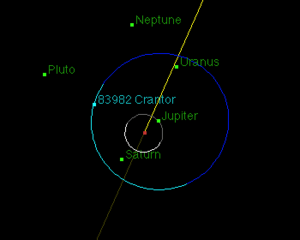83982 Crantor
|
A diagram showing the orbits of Crantor and Jupiter. | |
| Discovery | |
|---|---|
| Discovered by | Near-Earth Asteroid Tracking (NEAT) project |
| Discovery site | Palomar |
| Discovery date | 12 April 2002 |
| Designations | |
| MPC designation | 83982 |
Named after | Crantor |
| 2002 GO9 | |
| Orbital characteristics[1] | |
| Epoch 13 January 2016 (JD 2457400.5) | |
| Uncertainty parameter 2 | |
| Observation arc | 4882 days (13.37 yr) |
| Aphelion | 24.778 AU (3.7067 Tm) |
| Perihelion | 14.017 AU (2.0969 Tm) |
| 19.398 AU (2.9019 Tm) | |
| Eccentricity | 0.27738 |
| 85.44 yr (31205.2 d) | |
| 57.5235° | |
| 0.0115365°/day | |
| Inclination | 12.78529° |
| 117.4037° | |
| 92.6730° | |
| Earth MOID | 13.0385 AU (1.95053 Tm) |
| Jupiter MOID | 8.74688 AU (1.308515 Tm) |
| Physical characteristics | |
| Dimensions |
60+15 −13 km[2] |
| 13.94 h (0.581 d) | |
Sidereal rotation period | 13.94[1] |
| 8.8[1] | |
|
| |
83982 Crantor /ˈkræntɔːr/, provisionally known as 2002 GO9, is a centaur[3] in a 1:1 mean-motion resonance with Uranus.[4][5]
Discovery
(83982) 2002 GO9 was discovered on April 12, 2002 by the Near-Earth Asteroid Tracking (NEAT) program at Palomar. It is named after the Lapith Crantor.
Orbit
Crantor follows a moderately eccentric orbit (eccentricity of 0.27) with a semi-major axis of 19.36 AU and an inclination of 12.78º.[6]
Physical properties
Crantor is a relatively large minor body with an absolute magnitude of H=8.5, translating into a diameter of around 60 km.[6] Water ice has been detected on Crantor with a confidence of more than 3σ (99.7%).[2]
Co-orbital with Uranus
Crantor was first suggested as a possible co-orbital of Uranus in 2006.[4] Crantor follows a complex, transient horseshoe orbit around Uranus. Classical horseshoe orbits include the Lagrangian points L3, L4, and L5, but Crantor's horseshoe orbit also brings it near Uranus. The motion of Crantor is mainly controlled by the influence of the Sun and Uranus, but Saturn has a significant destabilizing effect. The precession of the nodes of Crantor is accelerated by Saturn, controlling its evolution and short-term stability.[5]
References
- 1 2 3 "JPL Small-Body Database Browser: 83982 Crantor". Jet Propulsion Laboratory. Retrieved 25 March 2016.
- 1 2 Near-infrared spectra of centaurs and Kuiper belt objects
- ↑ MPC list of Centaurs
- 1 2 Gallardo, T. (September 2006). "Atlas of the mean motion resonances in the Solar System". Icarus. 184 (1): 29–38. Bibcode:2006Icar..184...29G. doi:10.1016/j.icarus.2006.04.001.
- 1 2 de la Fuente Marcos, Carlos; de la Fuente Marcos, Raúl (March 2013). "Crantor, a short-lived horseshoe companion to Uranus". Astronomy and Astrophysics. 551: A114(8 pages). arXiv:1301.0770
 . Bibcode:2013A&A...551A.114D. doi:10.1051/0004-6361/201220646.
. Bibcode:2013A&A...551A.114D. doi:10.1051/0004-6361/201220646. - 1 2 JPL's Solar System Dynamics data on Crantor
- Further reading
- Atlas of the mean motion resonances in the Solar System Gallardo, T. 2006, Icarus, Volume 184, Issue 1, p. 29-38.
- Crantor, a short-lived horseshoe companion to Uranus de la Fuente Marcos, Carlos; & de la Fuente Marcos, Raúl (2013), Astronomy and Astrophysics, Volume 551, A114 (8 pages).
External links
- This is an image of Crantor taken by the SDSS telescope on 16APR2002 when it was 13.1au from Earth /Fermats Brother
- Three centaurs follow Uranus through the solar system (Jun 18, 2013)
- 83982 Crantor at the JPL Small-Body Database

